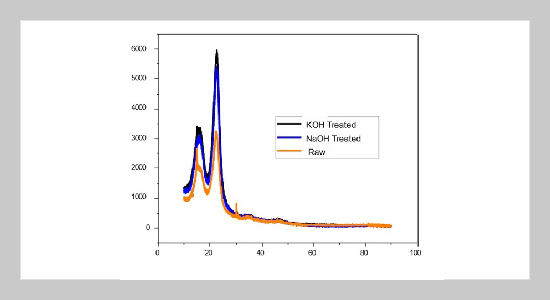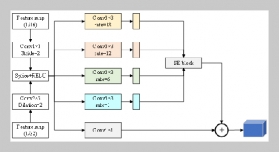REFERENCES
- [1] A. C. Jadhav, P. Pandit, T. N. Gayatri, P. P. Chavan, and N. C. Jadhav. Production of Green Composites from Various Sustainable Raw Materials. Ed. by S. S. Muthu. 2019. DOI: 10.1007/978-981-13-1969-3_1.
- [2] H. Khalili, M. H. Salim, S.-e. J. Tlemcani, R. Makhlouf, F.-Z. S. A. Hassani, H. Ablouh, Z. Kassab, and M. E. Achaby, (2022) “Bio-Nanocomposite Films Based on Cellulose Nanocrystals Filled Polyvinyl Alcohol/Alginate Polymer Blend" Journal of Fibers and Polymer Composites 1: 77–96. DOI: 10.55043/jfpc.v1i2.56.
- [3] N. H. Sari, I. N. G. Wardana, Y. S. Irawan, and E. Siswanto, (2018) “Characterization of the Chemical, Physical, and Mechanical Properties of NaOH-treated Natural Cellulosic Fibers from Corn Husks" Journal of Natural Fibers 15: 545–558. DOI: 10.1080/15440478. 2017.1349707.
- [4] S. O. Ismail, E. Akpan, and H. N. Dhakal, (2022) “Review on natural plant fibres and their hybrid composites for structural applications: Recent trends and future perspectives" Composites Part C: Open Access 9: 100322. DOI: https://doi.org/10.1016/j.jcomc.2022.100322.
- [5] Q. Zhang, Y. Ma, Z. Qi, C. Jia, Y. Yao, and D. Zhang, (2022) “Optimisation on uniformity and compressibility of rapeseed straw cellulose fiber mixtures for straw/mineral hybrid natural fiber composite" Industrial Crops and Products 189: 115852. DOI: https://doi.org/10.1016/j.indcrop.2022.115852.
- [6] N. H. Sari and Y. A. Padang, (2019) “The characterization tensile and thermal properties of hibiscus tiliaceus cellulose fibers" IOP Conference Series: Materials Science and Engineering 539: 012031. DOI: 10.1088/1757-899X/539/1/012031.
- [7] P. Pandit, M. D. Teli, K. Singha, S. Maiti, and S. Maity, (2021) “Extraction and characterization of novel Sterculia foetida fruit shell fibre for composite applications" Cleaner Engineering and Technology 4: 100194. DOI: https://doi.org/10.1016/j.clet.2021.100194.
- [8] N. H. Sari, A. Rahman, and E. Syafri. Characterization of Musaceae and Saccharum Officinarum Cellulose Fibers for Composite Application. 2019.
- [9] N. M. Nurazzi, A. Khalina, M. Chandrasekar, H. A. Aisyah, S. A. Rafiqah, R. A. Ilyas, and Z. M. Hanafee, (2020) “Effect of fiber orientation and fiber loading on the mechanical and thermal properties of sugar palm yarn fiber reinforced unsaturated polyester resin composites" Polimery 65: 115–124. DOI: 10.14314/polimery.2020.2.5.
- [10] X. Han, L. Ding, Z. Tian,W.Wu, and S. Jiang, (2021) “Extraction and characterization of novel ultrastrong and tough natural cellulosic fiber bundles from manau rattan (Calamus manan)" Industrial Crops and Products 173: 114103. DOI: https://doi.org/10.1016/j.indcrop.2021.114103.
- [11] D. Wahjuningrum, M. Hasanah, R. Departemen, B. Perairan, F. Perikanan, I. Kelautan, and I. P. Bogor, (2016) “Efikasi daun sembukan Paederia foetida untuk pencegahan infeksi bakteri Aeromonas hydrophila pada ikan nila Effication of skunkvine leaves Paederia foetida for prevention of Aeromonas hydrophila infection on tilapia" Jurnal Akuakultur Indonesia 15: 108–116. DOI: 10.19027/jai.15.2.108-116.
- [12] N. H. Sari, J. Fajrin, Suteja, and A. Fudholi, (2020) “Characterisation of swellability and compressive and impact strength properties of corn husk fibre composites" Composites Communications 18: 49–54. DOI: https://doi.org/10.1016/j.coco.2020.01.009.
- [13] B. A. Praveena, A. Buradi, N. Santhosh, V. K. Vasu, J. Hatgundi, and D. Huliya, (2022) “Study on characterization of mechanical, thermal properties, machinability and biodegradability of natural fiber reinforced polymer composites and its Applications, recent developments and future potentials: A comprehensive review" Materials Today: Proceedings 52: 1255–1259. DOI: https://doi.org/10.1016/j.matpr.2021.11.049.
- [14] A. E. Bekele, H. G. Lemu, and M. G. Jiru, (2022) “Experimental study of physical, chemical and mechanical properties of enset and sisal fibers" Polymer Testing 106: 107453. DOI: https://doi.org/10.1016/j.polymertesting.2021.107453.
- [15] N. Shanmugasundaram, I. Rajendran, and T. Ramkumar, (2018) “Static, dynamic mechanical and thermal properties of untreated and alkali treated mulberry fiber reinforced polyester composites" Polymer Composites 39: E1908–E1919. DOI: https://doi.org/10.1002/pc.24890.
- [16] M. Khan, S. Rahamathbaba, M. A. Mateen, D. V. R. Shankar, and M. M. Hussain, (2019) “Effect of NaOH treatment on mechanical strength of banana/epoxy laminates" Polymers from Renewable Resources 10: 19–26. DOI: 10.1177/2041247919863626.
- [17] N. A. F. M. Nasir, J. Jamaluddin, Z. Zainudin, M. M. Busheri, N. Adrus, F. S. S. Azim, and R. Hasham, (2020) “The effect of alkaline treatment onto physical, thermal, mechanical and chemical properties of Lemba leaves fibres as new resources of biomass" Pertanika Journal of Science and Technology 28: 1531–1547. DOI:10.47836/pjst.28.4.21.
- [18] S. Maity, P. Paul, K. Singha, D. P. Gon, and M. Singha, (2012) “A Review on Jute Nonwovens: Manufacturing, Properties and Applications Engineering Fibers for Fog Harvesting and Interfacial Solar Water Purification View project Electro-conductive textiles View project A Review on Jute Nonwovens: Manufacturing, Properties and Applications" International Journal of Textile Science 2012: 36–43. DOI: 10.5923/j.textile.20120105.02.
- [19] R. Liu, H. Xiao, S. D. Pang, J. Geng, and H. Yang, (2020) “Application of Sterculia foetida petiole wastes in lightweight pervious concrete" Journal of Cleaner Production 246: 118972. DOI: https://doi.org/10.1016/j.jclepro.2019.118972.
- [20] A. Amiri, Z. Triplett, A. Moreira, N. Brezinka, M. Alcock, and C. A. Ulven, (2017) “Standard density measurement method development for flax fiber" Industrial Crops and Products 96: 196–202. DOI: https://doi.org/10.1016/j.indcrop.2016.11.060.
- [21] A. Bazargan, T. Gebreegziabher, C.-W. Hui, and G. McKay, (2014) “The effect of alkali treatment on rice husk moisture content and drying kinetics" Biomass and Bioenergy 70: 468–475. DOI: https://doi.org/10.1016/j.biombioe.2014.08.018.
- [22] O. Faruk, A. K. Bledzki, H.-P. Fink, and M. Sain, (2012) “Biocomposites reinforced with natural fibers: 2000–2010" Progress in Polymer Science 37: 1552–1596. DOI: https://doi.org/10.1016/j.progpolymsci.2012.04.003.
- [23] B. S. L. Brito, F. V. Pereira, J.-L. Putaux, and B. Jean, (2012) “Preparation, morphology and structure of cellulose nanocrystals from bamboo fibers" Cellulose 19: 1527–1536. DOI: 10.1007/s10570-012-9738-9.
- [24] S. G. Subramanian, R. Rajkumar, and T. Ramkumar, (2021) “Characterization of Natural Cellulosic Fiber from Cereus Hildmannianus" Journal of Natural Fibers 18: 343–354. DOI: 10.1080/15440478.2019.1623744.
- [25] K. H. Reddy, R. M. Reddy, M. Ramesh, D. M. Krishnudu, B. M. Reddy, and H. R. Rao, (2021) “Impact of Alkali Treatment on Characterization of Tapsi (Sterculia Urens) Natural Bark Fiber Reinforced Polymer Composites" Journal of Natural Fibers 18: 378–389. DOI: 10.1080/15440478.2019.1623747.
- [26] G. M. A. Khan, M. S. A. Shams, M. R. Kabir, M. A. Gafur, M. Terano, and M. S. Alam, (2013) “Influence of chemical treatment on the properties of banana stem fiber and banana stem fiber/coir hybrid fiber reinforced maleic anhydride grafted polypropylene/low-density polyethylene composites" Journal of Applied Polymer Science 128: 1020–1029. DOI: https://doi.org/10.1002/app.38197.
- [27] B. M. Cherian, A. L. Leão, S. F. de Souza, S. Thomas, L. A. Pothan, and M. Kottaisamy, (2010) “Isolation of nanocellulose from pineapple leaf fibres by steam explosion" Carbohydrate Polymers 81: 720–725. DOI: https://doi.org/10.1016/j.carbpol.2010.03.046.
- [28] R. A. Ilyas, S. M. Sapuan, M. R. Ishak, and E. S. Zainudin, (2017) “Effect of delignification on the physical, thermal, chemical, and structural properties of sugar palm fibre" BioResources 12: 8734–8754. DOI: 10.15376/biores.12.4.8734-8754.
- [29] M. Truong, W. Zhong, S. Boyko, and M. Alcock, (2009) “A comparative study on natural fibre density measurement" The Journal of The Textile Institute 100: 525–529. DOI: 10.1080/00405000801997595.
- [30] M. V. Maheshwaran, N. R. J. Hyness, P. Senthamaraikannan, S. S. Saravanakumar, and M. R. Sanjay, (2018) “Characterization of natural cellulosic fiber from Epipremnum aureum stem" Journal of Natural Fibers 15: 789–798. DOI: 10.1080/15440478.2017.1364205.
- [31] M. Arsyad, (2017) “Effect of Alkali Treatment on The Coconut Fiber Surface" ARPN Journal of Engineering and Applied Sciences 12:
- [32] Y.Wu, Y. Zheng, F. Yang, and L. Yang, (2021) “Preparation process and characterization of mechanical properties of twisted bamboo spun fiber bundles" Journal of Materials Research and Technology 14: 2131–2139. DOI:https://doi.org/10.1016/j.jmrt.2021.07.080.
- [33] M. N. Norizan, K. Abdan, M. S. Salit, and R. Mohamed, (2017) “Physical, mechanical and thermal properties of sugar palm yarn fibre loading on reinforced unsaturated polyester composites." Journal of Physical Science 28(3):
- [34] D. Atalie and R. K. Gideon, (2018) “Extraction and characterization of Ethiopian palm leaf fibers" Research Journal of Textile and Apparel 22: 15–25. DOI: 10.1108/RJTA-06-2017-0035.
- [35] D. Watkins, M. Nuruddin, M. Hosur, A. Tcherbi-Narteh, and S. Jeelani, (2015) “Extraction and characterization of lignin from different biomass resources" Journal of Materials Research and Technology 4: 26–32. DOI: https://doi.org/10.1016/j.jmrt.2014.10.009.
- [36] J. Sahari, S. M. Sapuan, E. S. Zainudin, and M. A. Maleque, (2013) “Mechanical and thermal properties of environmentally friendly composites derived from sugar palm tree" Materials Design 49: 285–289. DOI: https://doi.org/10.1016/j.matdes.2013.01.048.
- [37] A. Oushabi, S. Sair, F. O. Hassani, Y. Abboud, O. Tanane, and A. E. Bouari, (2017) “The effect of alkali treatment on mechanical, morphological and thermal properties of date palm fibers (DPFs): Study of the interface of DPF–Polyurethane composite" South African Journal of Chemical Engineering 23: 116–123. DOI: https://doi.org/10.1016/j.sajce.2017.04.005.
- [38] R. Vijay, A. Vinod, D. L. Singaravelu, M. R. Sanjay, and S. Siengchin, (2021) “Characterization of chemical treated and untreated natural fibers from Pennisetum orientale grass- A potential reinforcement for lightweight polymeric applications" International Journal of Lightweight Materials and Manufacture 4: 43–49. DOI: https://doi.org/10.1016/j.ijlmm.2020.06.008.
















